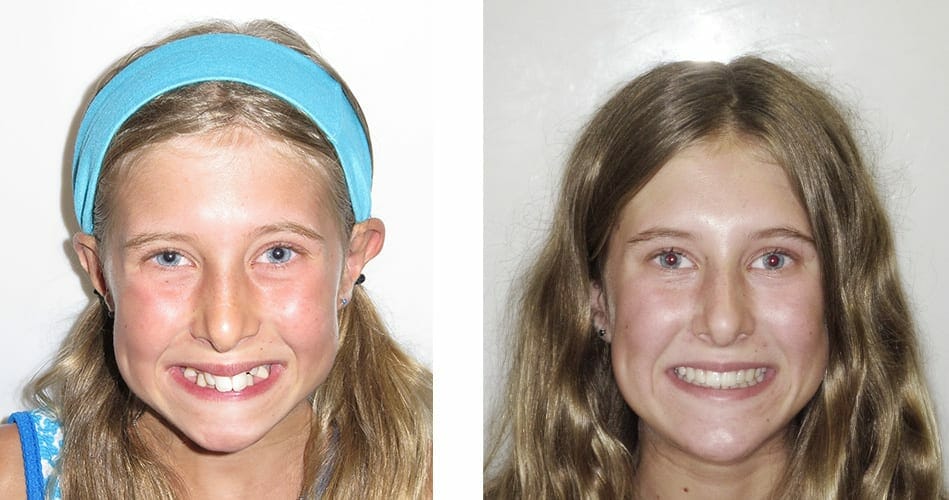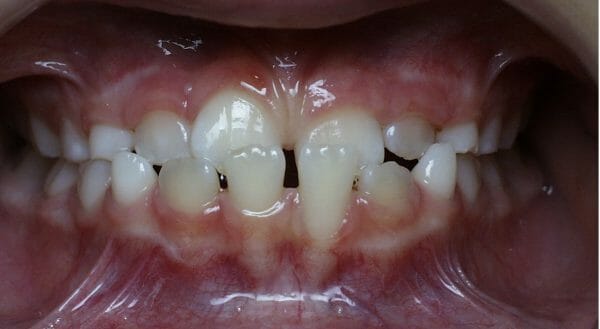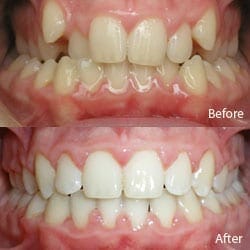Orthodontic challenges are as varied as the smiles they seek to refine. Each patient presents a unique set of bite issues, requiring a customized approach to treatment.
While the dental landscape offers many solutions for teeth alignment, the selection of a specific treatment often centers on the nature and complexity of the issue. The choice is not solely about esthetics; it is rooted in achieving optimal functionality and long-term oral health.
Dr. Ryan Redford and Dr. Michael Burke of Burke & Redford Orthodontists provide their expertise and a commitment to individualized care with over 30 years of experience to children and teenagers in the Inland Empire.
Severe Crowding and the Advantages of Braces
-
What Constitutes Severe Crowding?
Severe crowding is characterized by a lack of adequate space in the dental arch to accommodate the natural alignment of all teeth. This misalignment can result from a discrepancy between the jaw size and tooth size or due to premature loss of baby teeth. Manifesting as overlapped, rotated, or even twisted teeth, severe teeth crowding can pose not only esthetic concerns but also functional and hygienic challenges.

-
The Effectiveness of Braces in Exerting Force
Self-ligating braces are our preferred advanced orthodontic treatment of choice for severe crowding due to their ability to exert consistent and controlled force in any direction and over a prolonged period. Each bracket, carefully attached to specific points on individual teeth, works in conjunction with archwires to facilitate the strategic movement of teeth. This system provides orthodontists with the control to tackle even the most severely crowded mouths, making braces a compelling choice for such cases.
-
Severe Crowding Case Studies
Case Study 1: A 14-year-old presented with multiple overlapped front teeth, making brushing challenging. After 24 months with braces, not only was the alignment perfected, but the patient’s oral hygiene improved significantly.
Case Study 2: A 19-year-old had been self-conscious about her twisted incisors for years. Braces provided a predictable approach to correct the rotation, and within 18 months, she was proudly displaying a symmetrical and confident smile.
These are just a couple examples, but they underscore the profound impact that braces, when deployed expertly, can have on severe crowding scenarios.
Complex Rotations and Malpositions
-
Understanding the Challenges of Rotations and Malpositions
Complex rotations and malpositions present unique challenges in orthodontics. While a rotated tooth is one that has turned out of its normal position, malpositions refer to teeth that have erupted or moved to an incorrect location in the mouth. These misalignments can lead to an uneven bite, increased wear, and esthetic concerns. Addressing such issues requires precision, given that the treatment must not only realign the affected tooth but also ensure the harmony of the entire dental arch.

-
How Braces Offer Precise Control Over Individual Tooth Movement
Burke & Redford Orthodontists employ state-of-the-art self-ligating metal, ceramic, and Damon braces, each designed to cater to specific patient needs and preferences. The self-ligating feature of these braces allows for efficient adjustment appointments that are easy to tolerate.
In cases of complex rotations and malpositions, the precision of self-ligating braces combined with the esthetics of ceramic braces can provide optimal results in a discreet way. The periodic adjustment of the braces to exert targeted forces on the teeth allows Dr. Ryan Redford to address each tooth’s unique malposition or rotation.
-
Case Studies Illustrating Successful Treatment
Case Study 1: A 17-year-old had a severely rotated canine, making his bite uneven. Using Damon braces, the canine was expertly repositioned over 20 months, resulting in a harmonious bite and improved facial esthetics.
Case Study 2: A young woman, aged 22, had a malpositioned molar that impacted her ability to chew properly. With a combination of ceramic braces and strategic wire adjustments, the molar was brought into its correct position within a year, restoring her bite and confidence.
These cases demonstrate the transformative potential of braces in handling complex dental rotations and malpositions.
Overbites and Underbites: Beyond Aesthetics
-
Defining Severe Overbites and Underbites
An overbite refers to the extent of vertical overlap of the upper front teeth over the lower front teeth. While a minor overlap is considered normal, a pronounced overlap—where the lower teeth almost or completely disappear behind the upper teeth—is termed as a severe overbite.
Conversely, an underbite is characterized by the lower front teeth protruding forward, surpassing the upper front teeth. Both conditions are more than just cosmetic issues; they can lead to problems like uneven teeth wear, facial imbalance, and difficulties in speaking and eating.
-
The Role of Braces and Additional Appliances, Like Headgear
To address severe overbites and underbites, braces remain an invaluable tool. Self-ligating metal, ceramic, and Damon braces at Burke & Redford Orthodontists can correct teeth positioning. In extreme cases, additional orthodontic appliances may be necessary to use in conjunction with braces.
Headgear, for instance, is often used to treat underbites in growing children (typically between the ages of 7 and 10). It works by applying force to the upper teeth and jaw, helping promote forward growth of the upper jaw. Being proactive and addressing underbites in growing children can pay dividends later, sometimes preventing the need for more complicated surgical intervention to reposition the jaw.
-
Overbite and Underbite Case Studies
Case Study 1: An 8-year-old had a pronounced underbite which affected her ability to bite down normally and made her conscious of her “bulldog-like” appearance. By using nighttime headgear and some limited self-ligating braces, her bite was corrected over 12 months, enhancing her facial profile, and giving her the confidence to bite down comfortably.
Case Study 2: A 32-year-old male presented with a severe overbite, leading to excessive wear and breakdown of his front teeth. A combination of braces to correct the bite and bonding restorations with his dentist after braces effectively treated his broken-down smile over a period of 28 months.


Addressing Highly Complex Cases
-
The Challenges of Vertical Tooth Movement and Intruding Over-Erupted Teeth
Vertical tooth movement pertains to the upward or downward shifting of a tooth, aiming to level the position of the smile relative to the face and lips or adjust the tooth’s height relative to its neighbors. This type of movement can be difficult due to mechanical obstructions – either other teeth in the way or the natural resistance of the bone surrounding each tooth root.
Intrusion of a tooth (or group of teeth) can be particularly challenging and brings a set of unique challenges. Over eruption typically occurs when an opposing tooth is missing or there is no contact, causing the tooth to move out of its optimal position. Intrusion movements can be complex due to the need to move the tooth against the surrounding jawbone and the limited control over the force direction.
-
Why Braces are the Preferred Choice for Such Complexities
For both vertical tooth movements and intruding over-erupted teeth, the precision and control offered by braces are unparalleled. Self-ligating metal braces, ceramic braces, and Damon braces, like those used by Burke & Redford Orthodontists, provide a consistent force that can be minutely adjusted to ensure optimal results. The braces, with their anchor points and ability to apply multidirectional forces, offer an advantage over other orthodontic tools when intricate movements are required.
-
Over-Erupted Case Studies
Case Study 1: A 25-year-old woman had an over-erupted molar due to the early loss of its opposing tooth. Using self-ligating metal braces and a temporary anchorage device, the tooth re-intruded over 24 months, restoring balance to her bite and preventing further dental complications.
Case Study 2: A young man, 16, had a lower canine that erupted far below its adjacent teeth. Through the strategic application of vertical forces using ceramic braces, orthodontic results achieved a perfect alignment in just 16 months.
Navigating Impacted Teeth
-
Understanding Impacted Teeth and Their Challenges
Impacted teeth are those that have failed to erupt through the gums and into their expected position in the dental arch. This can occur due to a lack of space, obstructions from other teeth, or an unfavorable eruption path.
While wisdom teeth are commonly known to become impacted, any tooth can potentially face this challenge. Impacted teeth can lead to cyst formation, disrupt the alignment of other teeth, and damage the roots of adjacent teeth. Upper canine teeth are notorious for their potential to become impacted.

-
How Braces Can Guide Impacted Teeth to Their Rightful Positions
Braces, especially when combined with minor surgical procedures, can play a pivotal role in managing impacted teeth. Once the obstruction or cause of the impaction is addressed (sometimes through a minor surgical exposure of the impacted tooth), an orthodontic bracket can be bonded to the impacted tooth.
This bracket, with the help of the braces’ archwire or auxiliary tools, can then apply controlled force to guide the impacted tooth towards its correct position in the dental arch. The use of self-ligating metal, ceramic, and Damon braces provides Dr. Redford and Dr. Burke with the precision required to handle such intricate cases.
-
Impacted Teeth Case Studies
Case Study 1: A 15-year-old boy had an impacted canine located just above his front teeth, causing aesthetic concerns and potential damage to adjacent roots. With a combination of surgical exposure and ceramic braces, the canine was gently guided into its position over 26 months, enhancing his smile and bite function.
Case Study 2: A 9-year-old girl had an ectopic (potentially impacted) canine that was at risk for needing surgical exposure if not addressed. A conservative treatment plan of extracting the associated baby tooth and holding space with a retainer resulted in the spontaneous eruption of the wayward canine, relieving her of more invasive treatment and potential complications later.
Tandem Mechanics in Orthodontics
-
Introduction to Tandem Mechanics
Tandem mechanics refers to the simultaneous use of two distinct sets of orthodontic forces or mechanisms to address multiple orthodontic challenges. This advanced technique allows Dr. Ryan Redford and Dr. Michael Burke to efficiently address complex orthodontic issues, reducing treatment time and ensuring optimal outcomes. Given the intricacy of the approach, it requires an experienced orthodontist to apply these dual forces correctly, ensuring each force doesn’t counteract or impede the other.
-
Discussing Specific Scenarios
One of the classic examples of tandem mechanics is the concurrent treatment of an impacted tooth while realigning other teeth. For instance, while an impacted canine is being pulled down into its correct position, other teeth might be undergoing repositioning to create space, correct crowding, or achieve other orthodontic goals.
This simultaneous approach is especially useful in situations where there is urgency to correct one orthodontic problem, but other movements need to happen simultaneously. The precision required ensures the impacted tooth comes into position without adversely affecting the alignment of neighboring teeth.
Dr. Redford and Dr. Burke recommend interceptive orthodontics, where parents bring in their children for a free consultation and digital x-rays to ensure their oral health is progressing as it should. Many bite and tooth eruption problems during these consultations are caught early and treated, if necessary, and it is easier to treat while the child is still developing.
-
Tandem Mechanics Case Studies
Case Study 1: A 14-year-old patient had an impacted canine and moderate crowding of the anterior teeth. Using self-ligating braces, the teenager received treatment where the front teeth were aligned to create space while simultaneously exerting gentle forces with a special spring to bring down the impacted canine. Over 30 months, the patient achieved a harmonious smile with all teeth in their optimal positions.
Case Study 2: A 15-year-old male presented with crooked front teeth and a partially impacted lower 12-year molar. Using ceramic braces and a combination of tandem mechanics, the front teeth were straightened, and the 12-year molar was uprighted at the same time. The entire treatment took 26 months, and the patient had a transformed bite and smile.
The successful outcomes from these complex cases highlight not just the advantages of tandem mechanics but the importance in deploying advanced techniques to handle challenging orthodontic issues.
Skeletal Discrepancies and Combined Treatments
-
The Nature and Impact of Jaw Size or Position Discrepancies
Skeletal discrepancies refer to irregularities in the size, shape, or position of the jawbones. This can manifest as a mismatch between the upper and lower jaws, leading to issues such as overbite, underbite, or a laterally misaligned bite (crossbite).
Beyond esthetic concerns, skeletal discrepancies can have functional repercussions, affecting speech, mastication (chewing), and tooth attrition. These types of skeletal imbalances, if not too severe, can typically be addressed in a straightforward manner in growing kids. When a jaw size mismatch is severe or in patients who are no longer growing (adults), surgical correction may be necessary.

-
The Collaboration of Braces with Orthognathic Surgery
Braces alone may not suffice to correct skeletal discrepancies, as they primarily influence the position of individual teeth rather than the jaw’s positioning. This is where orthognathic (jaw) surgery comes into play. The surgery alters the jaw’s position, size, or shape to achieve a harmonious relationship between the upper and lower jaws.
Dr. Ryan Redford and Dr. Michael Burke work in collaboration with the orthognathic surgeon to ensure seamless treatment and great results.
In a combined approach:
- Pre-surgical orthodontics: Braces (such as self-ligating metal, ceramic, and Damon braces) are first applied to align the teeth within each jaw. This phase can last from several months to one or more years, depending on the case’s complexity.
- Orthognathic surgery: Once teeth are appropriately aligned, jaw surgery is performed to correct the skeletal discrepancy.
- Post-surgical orthodontics: Braces are kept on post-surgery to refine the bite and ensure the teeth fit together perfectly.
- Skeletal Discrepancies & Combined Treatment Case Studies
Case Study 1: A 24-year-old female had a significant underbite and crowding. The patient underwent pre-surgical orthodontic treatment using self-ligating ceramic braces for 18 months. Following this, she had a Le Fort osteotomy to correct her maxillary retrognathism. Post-surgery, her braces remained for another 12 months to perfect her bite. The result was a dramatic improvement in her facial profile and a harmonious bite.
Case Study 2: A 30-year-old male had an overbite that caused difficulty in chewing and occasional speech issues. Through the combined efforts of orthodontics using self-ligating metal braces and a bilateral sagittal split osteotomy procedure, his mandible (lower jaw) was repositioned forward. The post-surgical orthodontic phase lasted ten months, ensuring a stable and functional bite for the patient.
Choosing the Best Orthodontist for Your Family
-
Reinforcing the Value of Choosing the Right Orthodontic Treatment
Orthodontic treatment is not just about achieving a captivating smile; it is about ensuring the proper function and health of the teeth and jaws. As we have explored in this article, some dental and skeletal challenges require specialized approaches.
Choosing the right treatment method, whether it is braces, surgical intervention, or a combination of techniques, is pivotal to achieving excellent and lasting results. When approached correctly, orthodontics will not only transform appearances, it also significantly improves your quality of life.

-
The Commitment of Burke & Redford Orthodontists to Address Complex Cases
Through many years of training and hands-on experience, Dr. Ryan Redford and Dr. Michael Burke are very well known in Southern California as experts in the field of orthodontics.
Their proficiency is particularly pronounced when it comes to intricate cases that demand precision, foresight, and a deep understanding of both esthetics and function. Each patient who walks through the doors of Burke & Redford Orthodontists is treated with a tailored plan, designed to meet their specific needs, challenges, and goals.
-
Encouragement to Consult with Dr. Redford and Dr. Burke for Personalized Care
If you or a loved one faces orthodontic challenges, whether mild or complex, the expertise of Dr. Redford and Dr. Burke is just a free orthodontic consultation away. By partnering with these skilled professionals, you are entrusting your orthodontic care to experts committed to achieving the best possible outcomes. Parents have left hundreds of orthodontist reviews for our offices about how happy their children and teenagers are with their treatment from Burke & Redford Orthodontists over the years.
It’s not just about moving teeth—it’s about enhancing confidence, improving function, and ensuring optimal oral health. Reach out to Burke & Redford Orthodontists and take the first step towards a brighter and healthier smile.
– Consultation Process: Each consultation involves a comprehensive examination and discussion of potential treatment options tailored to the patient’s specific needs.
– Booking an Appointment: Appointments can be conveniently booked either by calling their office directly or through the Burke & Redford Orthodontists’ website.
– Preparation: Before the appointment, patients are encouraged to complete an online health history and prepare any questions or concerns to ensure all their queries are addressed during the consultation.
Burke & Redford Orthodontists in Temecula and Lake Elsinore
Temecula Office:
Address: 41238 Margarita Rd Ste 101 Temecula CA 92591
Phone: (951) 699-8011
Office Hours: M-F 9:00 a.m. – 5:00 p.m.
Lake Elsinore Office:
Address: 351 Railroad Canyon Rd Ste C, Lake Elsinore CA 92532
Phone: (951) 699-8011
Office Hours: Open 1st and 3rd Wednesdays 1:00 p.m. – 5:00 p.m.
For a transformative orthodontic experience well known for their expertise and compassionate care, give Burke & Redford Orthodontists a call today.
